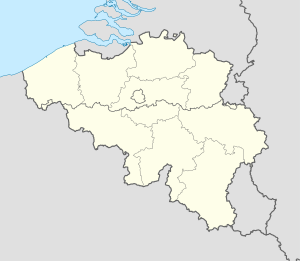Saint Peter's Abbey, Ghent
| Saint Peter's Abbey | |
|---|---|
Sint-Pietersabdij | |
 Saint Peter's Abbey | |
| General information | |
| Architectural style | Medieval Baroque |
| Address | Sint-Pietersplein 9 |
| Town or city | Ghent |
| Country | Belgium |
| Coordinates | 51°2′31.7″N 3°43′36.1″E / 51.042139°N 3.726694°E |
| Owner | Historische Huizen Gent ("Historic Houses Ghent") |
| Website | |
| historischehuizen | |
Saint Peter's Abbey (
, Belgium, now a museum and exhibition centre.Saint Peter's was founded in the late 7th century by
In 984, Gerbert of Aurillac, director of the cathedral school of
Saint Peter's first decline began following the

However, the end was not far off, first with the
Around 1950 the city launched a programme of restoration, which is still ongoing, which began with the cloister and chapter house, then the west wing, including the old refectory and kitchens. Work on the wine cellars and attics was completed in the 1970s, and in 1982 work on the abbey gardens was completed, and in 1986 the terrace. In the 1990s restoration of the refectory wing began.[5]
The abbey is now used as a museum and exhibition centre, which in 2000 housed a major exhibition as part of the Year of Emperor Charles, and in October 2001 hosted the 88th meeting of the European Council.[5][6]
Burials in the Abbey
- Baldwin II, Margrave of Flanders
- Ælfthryth, Countess of Flanders
- Arnulf I, Count of Flanders
- Adele of Vermandois
- Baldwin III, Count of Flanders
- Arnulf II, Count of Flanders
- Rozala of Italy
- Ogive of Luxembourg
- Godfrey I, Count of Verdun
- Lu Zhengxiang
See also
References
- ^ a b c d "History". Sint-Pietersabdij. 2014. Retrieved 19 December 2014.
- ^ "St Peter's Abbey". Shaping: Norwich and Ghent. 2014. Retrieved 19 December 2014.
- ISBN 978-1-84794-532-7.
- ^ "Taxatio". www.dhi.ac.uk. Retrieved 2023-12-04.
- ^ a b "Restoration". Sint-Pietersabdij. 2014. Retrieved 19 December 2014.
- ^ "Fight against terrorism to dominate EU summit of Ghent". EurActiv. 2014. Retrieved 19 December 2014.
- ^ a b Bricka, Carl Frederik, ed. (1887–1905). Dansk biografisk Lexikon (in Danish). Vol. VI. Gerson–H. Hansen (1st ed.). Copenhagen: Gyldendal. pp. 566–567. Retrieved 4 March 2018 – via Project Runeberg.
External links
- Saint Peter's Abbey, Ghent on Facebook
- "St Peter's Abbey". Visit Ghent. 2014. Retrieved 19 December 2014.

